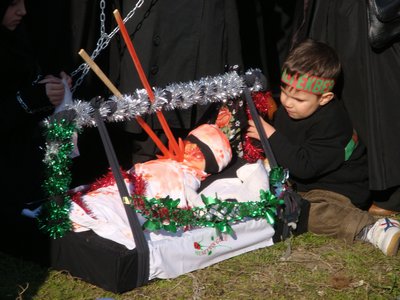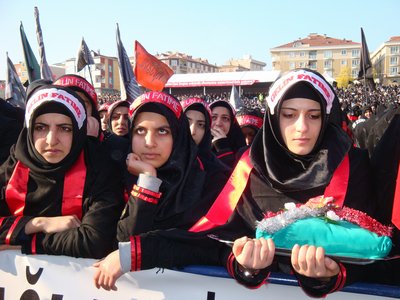Walking back through Aksaray on Sunday night I spotted a banner announcing that mourning for Ashura, the tenth day of Muharrem, the first month in the Islamic calendar, would be taking place in the Ashura Meydanı in Halkali the very next day. I was vaguely aware of Ashura as the day on which some of my neighbours would whip up bowls of aşure pudding from a seemingly random assortment of pantry leftovers. I also vaguely remembered that Ashura had something to do with the Shiites. Clearly the best way to learn more was to jump on the banliyö train to Halkali and see what happened, so that’s what I did today, with rather surprising results.
Actually, it would have been better to get out of the train at Küçükçekmece as Halkali station turns out to be in the middle of nowhere. “Cross the road and wait for a dolmuş,” another passenger advised me, even though that meant standing beside a busy main road and hoping for the best. Then a young woman clutching a camera came to join me, followed by two men likewise equipped. Soon the four of us were flagging down a minibus and boarding it as uncertainly as if we had found ourselves in the depths of the Congo rather than the western outskirts of İstanbul.
It was a long ride that took us past one of those new high-rise apartment complexes with which TOKİ is slowly strangling the city. My companion was a teacher from Pendik. “I didn’t know this was going on,” she said as we eyed it in disbelief. After ten minutes or so we arrived in what looked more like the real Halkali/Küçükçeşme. Even then there was quite a downhill walk to go but it was comforting to realise that the three Turks, just as much as I, had expected to step out of the station and be straight into the throng.
Then at last events began to unfold in front of us. First we came to a group of men carrying a banner inscribed in Arabic. They wore headbands inscribed “Ya Hüseyin” and briefly they turned to face each other and started to beat their chests rhythmically, whereupon at once I remembered that Ashura was the festival at which men used to beat themselves with whips and chains in memory of Hüseyin, the son of Ali and grandson of Mohammed, who had been killed in battle at Karbala in Iraq in 680. Soon after that we arrived in a square surrounded by mundane apartment blocks and small restaurants, many of them draped with banners representing Hüseyin and his companions. In some of them the Prophet Mohammed appeared, his face veiled in just the way I remembered from Iran but that I had never seen in Turkey before.
The best way to find out what was going on was from the bridge whence I could see that the entire square was now a sea of black with flags fluttering above it. Coming down again, I tried to go in and was turned gently back again. Way out, I presumed, before it dawned on me that this was a sexually segregated gathering and that I had tried to go in through the men’s entrance. With that little misunderstanding out of the way, I was soon crushed in with the other women, all of them except the photographers with their heads covered and most of them clad in black chadors.
Working my way to the front, I was soon confronted with some extraordinary and completely unexpected scenes. There were groups of women and children wearing green headscarves and complete face coverings. There were children dressed in white with red headbands. There were women in black with red headbands. There were women in black with red face veils like those worn by brides. Most scarily, there were women and children holding up what looked like bloodstained packages and children kneeling by cribs in which lay seemingly bloodstained babies, sometimes with sticks to represent arrows jutting out of their chests in memory of Ali Asgar, the six-month-old son of Hüseyin who also died at Karbala; think Christmas Nativity scenes but with a dead baby rather than a living one and you will get the general picture. In the background the constant drone of prayer was interspersed with fiery politicking about Iran and Israel. Every now and then the crowd would roar in response, raising their hands in the air, their wrists draped with symbolic chains.
To an outsider some of this seemed just plain grotesque. Why would make people want to hold up bloodstained shirts and cry for a man who died almost 1500 years ago, let alone clutch mementoes of a dead baby to their chests? Even for someone who lived through the mass hysteria following the death of Princess Diana it was hard to see women weeping and not be amazed at the tears. But presumably if one grows up in a Shiite household all this must seem as natural and normal as carol singing. Certainly, no one seemed to mind the photographers snapping away at the front of the crowd, even when they were men in amongst the women. It was almost as if we attending some vast school play with everyone playing their allotted role and expecting that it would attract attention.
Ashura used to be celebrated complete with flagellation in the courtyard of the Büyük Valide Han behind Kapalı Çarşı until it was banned in the 1970s. The ban on self-harming remains in place and today people donate blood to Kızılay instead. I came away from the event astounded at its raw authenticity and irresistible colourfulness. Ya Zeynep, the sister of Hüseyin. Ya Rukkaya, the sister of Ali Ahgar – there was so much here that was a complete mystery to me. Another page has been turned in my education about Turkey but a great deal more research will be needed before I can understand what I saw.
Written: 5 December 2011



